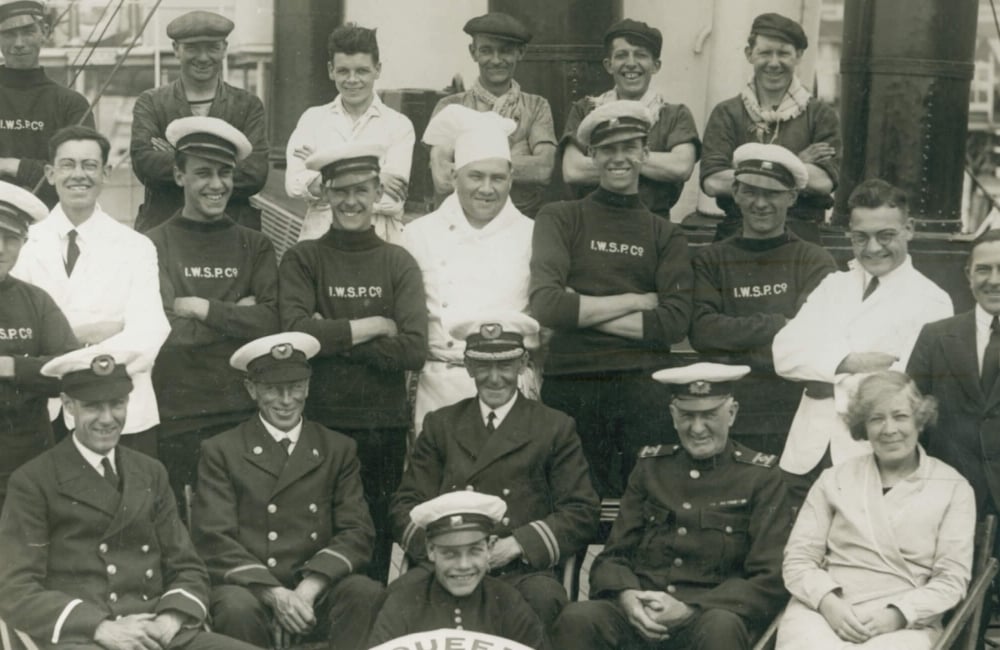Red Funnel has operated dozens of passenger vessels since the mid-1800s. Explore our archive of passenger vessels both past and present.
PS Gem
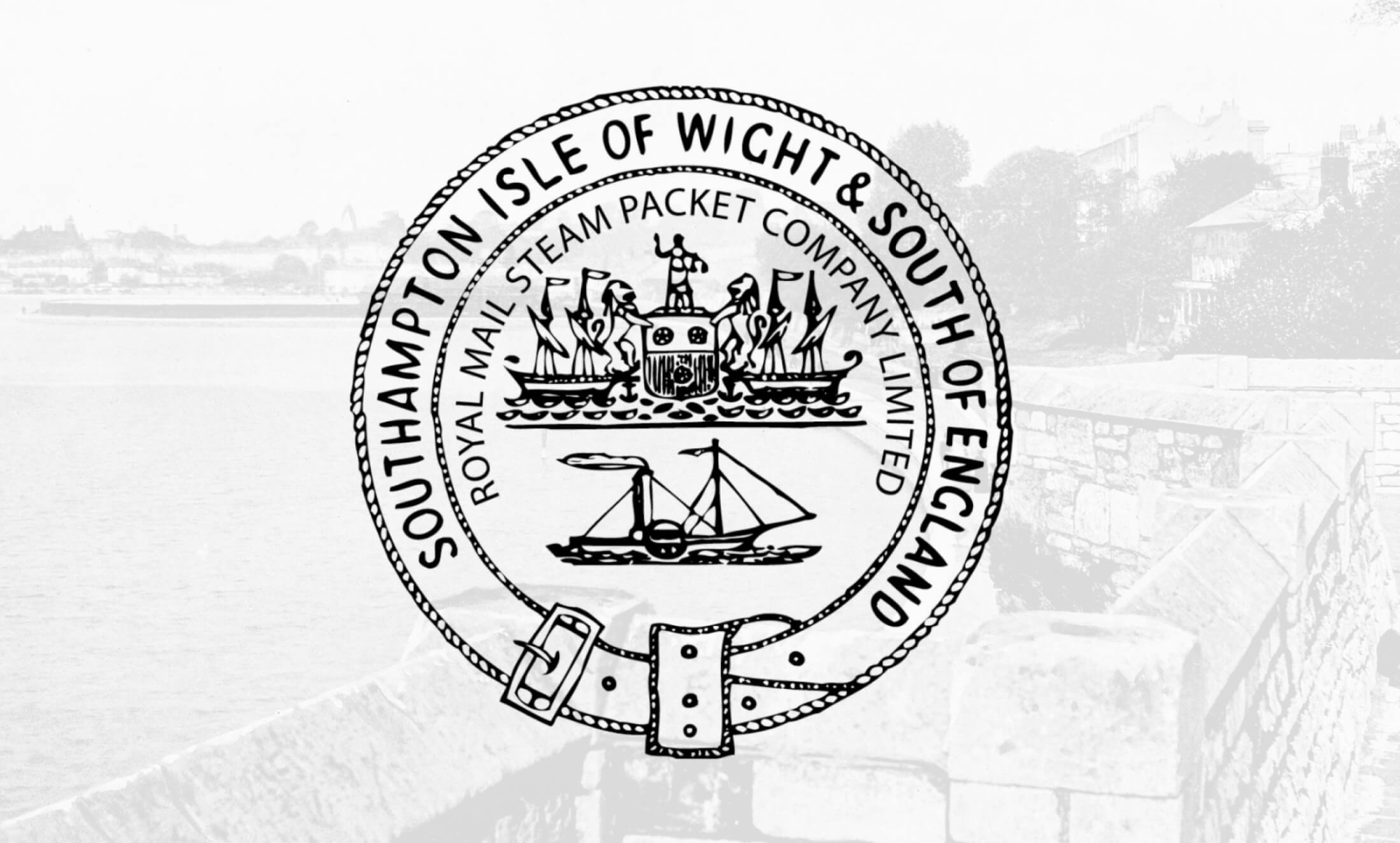
| Registration No. | 25119 |
|---|---|
| Builders | J.White, Cowes, Isle of Wight |
| Built | 1840 |
| Acquired | 1861 |
| Tonnage | 87 tonnes gross |
| Dimensions | 107'6" x 14'9" |
| Machinery | 40hp - paddle |
| Withdrawn | 1883 (scrapped 1889) |
Built for Isle of Wight Steam Packet Company and launched 5 September 1839. She was passed to the present company on its formation in 1861. In 1867 she was based in Cowes for tendering American liners in Cowes Roads, at a time when many Americans were coming ashore in Cowes. From 1869 she carried freight traffic and was finally withdrawn after 43 years service.
PS Ruby
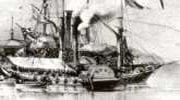
| Registration No. | 13862 |
|---|---|
| Builders | Day, Summers & Co. Northam |
| Built | 1841 |
| Acquired | 1861 |
| Tonnage | 103 tonnes gross |
| Dimensions | 114'9" x 16'4" |
| Machinery | 40hp - paddle |
| Withdrawn | 1872 (scrapped 1872) |
The first Isle of Wight steamer to be built of iron and ordered by the new competing concern, South Western & Isle of Wight Steam Navigation Co. She was launched 14 October 1840 at Northam as 'The Pride of the Waters' and after bankruptcy was acquired by the Isle of Wight Royal Mail Co. and renamed Ruby. She was one of the earliest excursion steamers, inaugurating a Southampton-Swanage voyage in 1849. From 1861 she was used for cargo duties but in 1870 she was hired by a priest to meet refugees crossing from France during the French/German War.
PS Pearl

| Registration No. | 13863 |
|---|---|
| Builders | Day, Summers & Co. Northam |
| Built | 1844 |
| Acquired | 1861 |
| Tonnage | 64 tonnes gross |
| Dimensions | 89'8" x 13'3" |
| Machinery | 32hp - paddle |
| Withdrawn | 1867 (scrapped 1875) |
Built of iron for Isle of Wight Royal Mail Co. and launched 2 May 1844. She was sold for £150 at public auction in 1867 after 23 years service.
PS Queen (I)
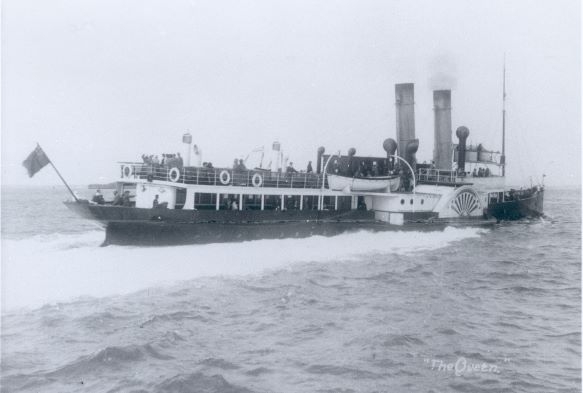
| Registration No. | 13865 |
|---|---|
| Builders | Day, Summers & Co. Northam |
| Built | 1848 |
| Acquired | 1861 |
| Tonnage | 93 tonnes gross |
| Dimensions | 117'1" x 14'0" |
| Machinery | 40hp - paddle |
| Withdrawn | 1876 (scrapped 1876) |
Built of iron for Isle of Wight Royal Mail Co. She hit the headlines in September 1868 for sinking the yacht Ulalie and again on 15 April 1874 when she transhipped the body of Dr David Livingstone from the P&O ship Malwa to the Royal Pier on route to Westminster Abbey for his funeral on 18 April 1874.
PS Medina (I)

| Registration No. | 13860 |
|---|---|
| Builders | J. White, Cowes, Isle of Wight |
| Built | 1852 |
| Acquired | 1861 |
| Tonnage | 104 tonnes gross |
| Dimensions | 120'8" x 14'9" |
| Machinery | 50hp - paddle |
| Withdrawn | 1882 (scrapped 1883) |
Acquired unused by Isle of Wight Royal Mail Co. as PS 'Times', she had lain engineless on the River Medina having been commisioned by a competing interest that had gone bankrupt. Engined by Summers, Day and Baldock, she was renamed 'Medina' and proved a fast and popular excursion boat. Although the first Medina of the present company, her predecessor of the same name 1822-1848 opened up many of the sea routes to steam, holding title of the first steamer into Guernsey in 1823, the first steamer to circumnavigate the Isle of Wight and known for occasional trips to Le Havre. Withdrawn after 21 years service.
PS Emerald
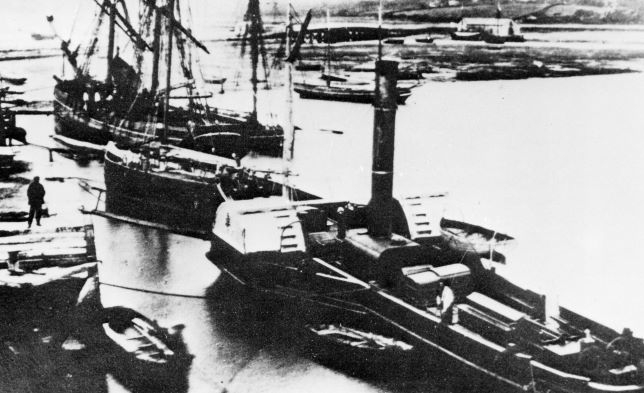
| Registration No. | 22532 |
|---|---|
| Builders | Day, Summers & Co. Northam |
| Built | 1857 |
| Acquired | 1861 |
| Tonnage | 69 tonnes gross |
| Dimensions | 105'0" x 14'1" |
| Machinery | 32hp oscillating - paddle |
| Withdrawn | 1871 |
Built of iron for Isle of Wight Steam Packet Co. with oscillating engines. She was often based in Yarmouth running into Cowes to feed the main packet service. She retired after 10 years with the Company and was sold to the Spanish.
PS Sapphire

| Registration No. | 29130 |
|---|---|
| Builders | CA Day, Northam, Southampton |
| Built | 1860 |
| Acquired | 1861 |
| Tonnage | 82 tonnes gross |
| Dimensions | 120'3" x 14'5" |
| Machinery | 40hp oscillating - paddle |
| Withdrawn | 1873 |
Built of iron with two oscillating engines and Morgan's patented feathering paddles for the Isle of Wight Steam Packet Co. On her trials she ran from Southampton to Portsmouth via Cowes in 1 hr 50 minutes. In April 1864 she was used by the Italian statesman Giuseppe Garibaldi who sailed to Cowes to visit Lord Alfred Tennyson at Farringford. Sapphire was withdrawn after 12 years service and sold to the Spanish.
PS Lord of the Isles
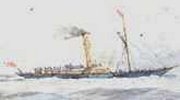
| Registration No. | 29100 |
|---|---|
| Builders | Thames Shipbuilding Co. |
| Built | 1861 |
| Acquired | 1865 |
| Tonnage | 126 tonnes gross |
| Dimensions | 145'0" x 18'1" |
| Machinery | oscillating paddle |
| Withdrawn | 1889 (scrapped 1889) |
Built for the competing Southampton, Isle of Wight and Portsmouth Improved Steam Boat Co. this iron hulled Solent steamer was the first to have deckhouse saloons, a ladies cabin, hot water pipe heating and even a promenade deck with seats and a handrail. Her maiden voyage was on 6 May 1861 where she made 14.18 knots over the Stokes Bay measured mile. Within a year her owners were bankrupt and she was purchased by the newly formed Red Funnel in 1865. On 1 August 1871 she was deployed on the R.Y.S Cowes fireworks excursion from Portsmouth and Ryde but drifted across the bows of another Southampton steamer. In the pursuing investigation she was found to have 400 passengers aboard despite a certificate for only 208. From 1883 until retirement Lord of the Isles was used for cargo duties.
PS Lady of the Lake
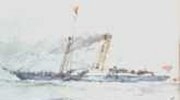
| Registration No. | 43772 |
|---|---|
| Builders | Thames Shipbuilding Co. |
| Built | 1861 |
| Acquired | 1865 |
| Tonnage | 104 tonnes gross |
| Dimensions | 147'6" x 17'9" |
| Machinery | oscillating paddle |
| Withdrawn | 1887 (scrapped 1887) |
Sister ship to Lord of the Isles and again built for the opposition, the Southampton, Isle of Wight and Portsmouth Improved Steam Boat Co. This steamer was acquired by Red Funnel in 1865 for passenger duties. She had a perculiar forward saloon which was oval in shape and the aft saloon did not extend the full width of the hull. In 1882 she was modified for cargo work.
PS Vectis
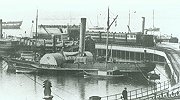
| Registration No. | 56125 |
|---|---|
| Builders | J. White & Co, Cowes |
| Built | 1866 |
| Acquired | 1866 |
| Tonnage | 137 tonnes gross |
| Dimensions | 150'6" x 18'2" |
| Machinery | 60hp paddle |
| Withdrawn | 1910 (scrapped 1911) |
This wooden hulled steamer was the first built for the Southampton Isle of Wight and South of England Royal Mail Steam Packet Company Limited ("Red Funnel") and was launched on 14 June 1866 by Miss Elizabeth Lamb, daughter of the Chairman. In 1870 Vectis was used to tow the yacht 'Cambria' from Cowes to the Nab for the start of 3 races with the yacht 'Sappho'. PS Ruby was used to tow 'Sappho' but required assistance from Vectis due to the strong wind. With officials aboard, she escorted the yachts eastwards to Beachy Head before returning to Cowes arriving at 3am the next day. Cambria won the race, arriving in Cowes at 4am and Sappho at 6am! With newer ships taking over excursion work, Vectis was used on the packet services until 1887 when she was converted into a cargo steamer - the removal of her clipper bow reduced her length to 140'8".
PS Southampton
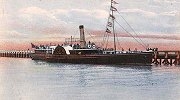
| Registration No. | 62236 |
|---|---|
| Builders | Barclay, Curle & Co Ltd Glasgow |
| Built | 1872 |
| Acquired | 1872 |
| Tonnage | 203 tonnes gross |
| Dimensions | 150'1" x 20'0" |
| Machinery | compound diagonal, paddle |
| Withdrawn | 1902 (scrapped 1915) |
Southampton was the first of a series of iron-hulled ships built on the Clyde. She had a narrow deck saloon aft, an open foredeck, a foredeck wheel in front of the funnel and engine room telegraphs fitted to the forward sponsons. Later she was fitted with a plank bridge aft of the funnel between the paddle boxes and given a new boiler in 1897 by Fay & Co. in Northam, she was sold in 1902.
PS Carisbrooke
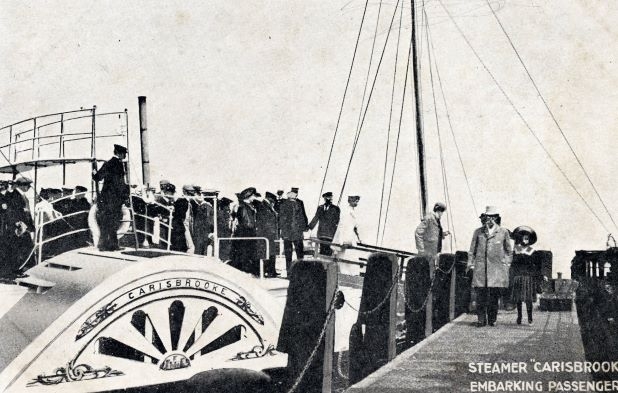
| Registration No. | 72360 |
|---|---|
| Builders | Barclay, Curle & Co Ltd Glasgow |
| Built | 1876 |
| Acquired | 1876 |
| Tonnage | 198 tonnes gross |
| Dimensions | 165'7" x 20'1" |
| Machinery | 70hp compound oscillating, paddle |
| Withdrawn | 1905 (scrapped 1935) |
Launched on 26 January 1876, she left Glasgow on 25 March arriving in Southampton after a stormy passage on the 31 March. Unlike the modern PS Southampton, the Company reverted to the 'old style' with this ship, fitting compound oscillating engines with a funnel aft of the paddle box. She started life on excursion and tendering duties. In September 1893 when backing out of Cowes at night she sank the yacht 'Titania' and cost the Company £485 1s. 0d. Carisbrooke was reboilered in 1889 and redecked in 1895 but the need for another new boiler in 1905 led to the decision to sell her to the Colwyn Bay & Liverpool Steamship Co. Ltd.
PS Prince Leopold
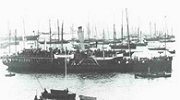
| Registration No. | 72361 |
|---|---|
| Builders | Barclay, Curle & Co Ltd Glasgow |
| Built | 1876 |
| Acquired | 1905 |
| Tonnage | 196 tonnes gross |
| Dimensions | 165'6" x 20'1" |
| Machinery | 70hp compound oscillating, paddle |
| Withdrawn | 1905 (wrecked 1908) |
Arriving from Glasgow on 17 April 1876, Prince Leopold's career was very similar to sister ship PS Carosbrooke. She collided with Yarmouth Pier in August 1876 causing £200 worth of damage to her port sponson, deck and pantry. She was reboilered in 1889, redecked in 1895 and sold to the Colwyn Bay & Liverpool Steamship Co. in 1906.
PS Princess Beatrice
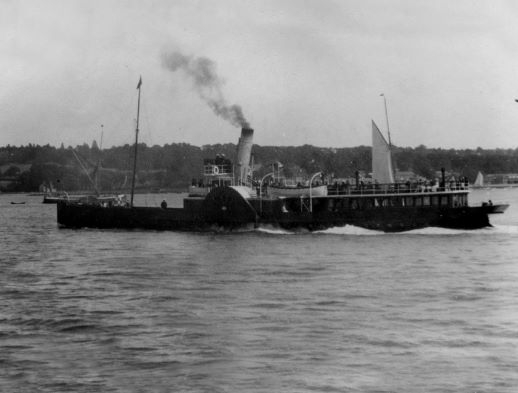
| Registration No. | 82408 |
|---|---|
| Builders | Barclay, Curle Co Ltd Glasgow |
| Built | 1880 |
| Acquired | 1880 |
| Tonnage | 253 tonnes gross |
| Dimensions | 175'7" x 20'1" |
| Machinery | 90hp compound diagonal, paddle |
| Withdrawn | 1930 (scrapped 1933) |
This steamer was an improved version of the PS Southampton reverting back to compound diagonal engines with the funnel forward of the paddle boxes. Her maiden voyage was to Alum Bay on 9th June 1880 and was the first steamer to call at Lee-on-Solent Pier on the day it was opened. On the 28 October 1897 she was badly damaged by PS Altrato whilst berthed in Southampton Docks. She was was repaired by Day, Summers & Co at Northam at the expense of Altrato's owners. She was reboilered in 1893 and fitted with electric light during her 1908/9 refit. During the Great war she served as a minesweeper but returned to service with the Company until her final run on 19th December 1930. She was laid up at Northam until March 1933 and then sold to Pollock, Brown & Co for scrap.
PS Princess Helena
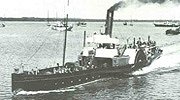
| Registration No. | 86341 |
|---|---|
| Builders | Barclay, Curle Co. Ltd Glasgow |
| Built | 1883 |
| Acquired | 1883 |
| Tonnage | 246 tonnes gross |
| Dimensions | 175'4" x 20'2" |
| Machinery | 90hp compound diagonal, paddle |
| Withdrawn | 1950 (scrapped 1952) |
Similar to the Princess Beatrice, Helena was launched 22 July 1883 and became proof of the longevity of the iron hull, remaining in service until 1952. Reboilered in 1893, fitted with electric light during the 1908/9 refit, she continued to operate excursions in the early 1900's. Although trialed by the Navy as a patrol vessel in the English Channel during WWI, she was rejected and returned to Red Funnel. The steamer did assist in May 1940 with the recovery of troops from Dunkirk in WWII, but was involved in a minor collision with the GWR steamer St. Helier off Dover. In 1945 her mast was removed to allow better access for vehicles on the foredeck, and in 1949 the elderly lady was placed on cargo duties where she remained as relief boat until 1952. That summer she was sold for scrap, but a high tide and gale caused her paddle arch to override the quay wall as she waited in line for the cutters torch. As the tide ebbed she heeled over and sank but was later pumped out, raised and scrapped as planned.
PS Her Majesty
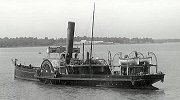
| Registration No. | 90419 |
|---|---|
| Builders | Barclay, Curle Co. Ltd Glasgow |
| Built | 1888 |
| Acquired | 1888 |
| Tonnage | 352 tonnes gross |
| Dimensions | 185'2" x 20'1" |
| Machinery | compound diagonal, paddle |
| Withdrawn | 1940 (scrapped 1940) |
Similar to Princess Beatrice and Princess Helena. Reboilered in 1901, she was fitted with electric light and new steam steering gear during the 1908/9 refit. Military service commenced in April 1917, acting as minesweeper with Princess Beatrice in the English Channel and Irish Sea. She returned to Red Funnel in 1919, was reconditioned and continued on the passage service until September 1927. Thereafter she was converted from a passenger steamer that carried cars on the open foredeck's to a car carrier. The mast was set back, the companion way from foredeck to promenade deck was removed, as was the aft saloon. In this form Her Majesty could carry 18 cars. She was used on both relief and scheduled services and also acted as a car and mail tender to liners like the Normandie, Nieuw Amsterdam, Bremen and Europa.
PS Princess of Wales
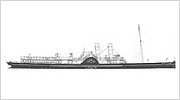
| Registration No. | n/a |
|---|---|
| Builders | Barclay, Curle & Co Ltd Glasgow |
| Built | 1888 |
| Acquired | N/A |
| Tonnage | 320 tonnes gross |
| Dimensions | 215'6" x 21'1" |
| Machinery | compound diagonal, paddle |
| Withdrawn | 1888 (lost at sea June 1888) |
The Princess of Wales, a two-funnelled ship with steam steering gear and a capacity to carry 600 passengers was famous for being the shortest serving ship in the Company's history! At 1pm on Saturday 16 June 1888 whilst on speed trials over the Skelmorlie measured mile on the Firth of Clyde, the brand new steamer was run down, cut in two and sank in a collision with former Castle Line steamer Balmoral Castle. A party from the Company and 50-60 others were rescued but a number of painters and joiners went down with the stern, all were plucked from the water with the exception of 3 painters who sadly lost their lives. The forepart of the Princess remained afloat and was taken in tow but it later sank in deep water. Efforts to raise her were not successful and she was declared a 'total loss'. The Board of Enquiry found both pilots guilty of negligence but it was later reported that she never attained her contract speed and it was questionable whether she would have been accepted. Her replacement, Solent Queen would incorporate several improvements.
PS Bangor Castle
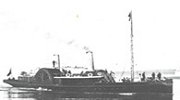
| Registration No. | not known |
|---|---|
| Builders | T Wingate & Co. Glasgow |
| Built | 1864 |
| Acquired | 1888 |
| Tonnage | 250 tonnes gross |
| Dimensions | 191'0" x 22'0" |
| Machinery | 2cyl simple diagonal, paddle |
| Withdrawn | 1888 (scrapped 1899) |
A two funnel ship with its bridge set between them and a pair of enormous paddle wheels, she was chartered for 3 months during the summer of 1988 from the Belfast, Bangor & Larne Steamboat Company to replace the Princess of Wales. Starting her career on the Thames, she was transferred to the Belfast to Bangor service in 1873. Her first sailing with Red Funnel was 26th June 1888 and she ended her stint with the Company by breaking down on her way to Ryde to pick up passengers for a round the Island excursion. She was rescued and towed to Cowes by Princess Beatrice.
PS Solent Queen (I)
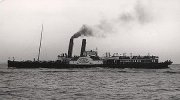
| Registration No. | 97201 |
|---|---|
| Builders | Barclay, Curle Co. Ltd Glasgow |
| Built | 1889 |
| Acquired | 1889 |
| Tonnage | 324 tonnes gross |
| Dimensions | 215'6" x 21'1" |
| Machinery | compound diagonal, paddle |
| Withdrawn | 1948 (scrapped 1948) |
This iron-hulled ship was built as a permanent replacement to the ill-fated Princess of Wales and incorporated a number of improvements. Launched on 3 April 1889 she attained a mean speed of 14.5 knots in the Gareloch on the 29 April. In her early days she was used mainly for excursion work and remained in the Company's service during the Great War. From 1921-1931 she spent the summer based in Bournemouth serving Swanage. On 27 April 1893 whilst berthed at the Royal Pier, Southampton she was gutted by a major fire but happily she was renovated and returned to service on the 20 July. A new boiler was fitted in 1902 and electric light in 1907. On the 3 December 1906 she was in collision with the ferry steamer Frances in Portsmouth Harbour but was again repaired. Like Princess Helena, she set off for Dunkirk but ran into difficulties and returned without troops. In August 1948, boiler failure led to her withdrawal and she was sold for scrap to TW Ward Ltd of Grays, Essex - arriving under tow on 31 October 1948. Her binnacle is in the National Maritime Museum at Greenwich.
PS Prince of Wales
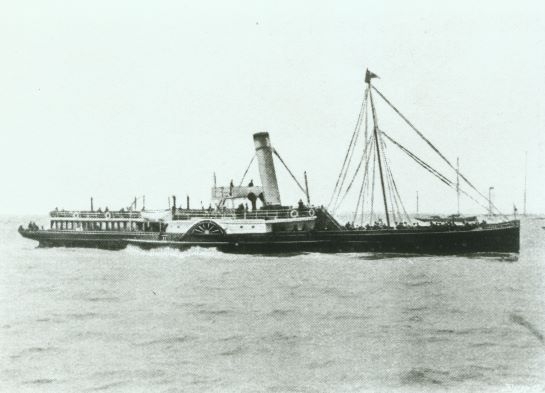
| Registration No. | 98850 |
|---|---|
| Builders | Southampton Naval Works, Woolston |
| Built | 1891 |
| Acquired | 1891 |
| Tonnage | 280 tonnes gross |
| Dimensions | 185'5" x 22'2" |
| Machinery | paddle compound diagonal |
| Withdrawn | 1937 (scrapped 1938) |
Built at Woolston unlike her Clyde built sisters, Prince of Wales cost £11,255 in 1891 and was the Company's first steel-hulled steamer. Launched on 7 July 1891, she was distinguishable by her tall single funnel, short waste steam pipe, extremely small paddle boxes, bow rudder and a hog-backed keel which was intended to counterbalance the tendency of paddle steamers to sag amidships under the weight and vibration of the engine and paddle gear. The thinking was that the keel would be depressed to neutralise the hogging but unfortunately she did not sag and carried this peculiarity throughout her life. At the Company's AGM in 1891 it was stated that various modifications had been made to enable her to attain 15 knots. During the winter of 1893/4 new paddle wheels with wooden floats were fitted to replace the steel originals that were the cause of excessive vibration - satisfactory speeds were recorded in trials over the Stokes Bay measured mile. Always prone to mishaps the Prince of Wales had a colourful life. Incidents include a collision with Clarence Pier on 23 March 1896, fouling a buoy in Cowes fairway on 3 June 1901 and colliding with a submarine in Portsmouth Harbour on 16 December 1903 in which she came close to being lost. In December 1927, when backing into Cowes fairway she collided with the yacht Cuffrida and the two vessels became locked together - it took Lord Elgin and two tugs to separate them! She was in the wars on 2 July 1934 after a minor collision with Princess Helena off Cowes and in the news again on 3 June 1935 after sinking the yacht Robin that was on its maiden voyage. After 36 years service the Prince of Wales was withdrawn and towed to Llanelli in March 1938 for breaking up.
PS Duchess of York / Duchess of Cornwall
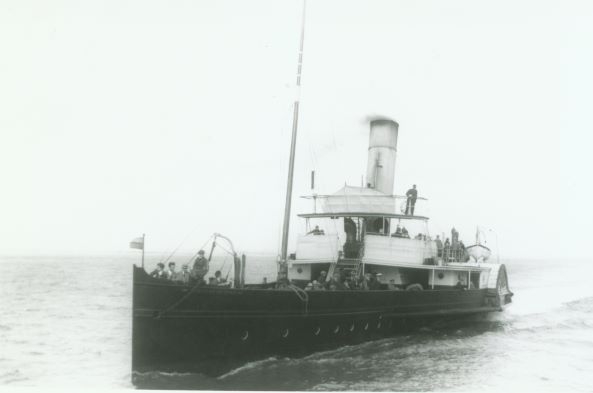
| Registration No. | 106903 |
|---|---|
| Builders | Barclay, Curle Co. Ltd Glasgow |
| Built | 1896 |
| Acquired | 1896-1916 / 1921-1949 |
| Tonnage | 302 tonnes gross |
| Dimensions | 185'5" x 22'1" |
| Machinery | compound diagonal, paddle |
| Withdrawn | 1949 (scrapped 1949) |
Ordered as a replacement for Her Majesty (which later returned to service), the Duchess of York was launched on 28 May 1896 and averaged 14.865 knots (and a maximum of 16.143 knots) in trials. Similar to the Prince of Wales, minus her peculiarities she had slightly bigger paddle boxes and a flatter funnel. In May 1916 she was sold to the Admiralty for minesweeping duties in the Mediterranean and Aegean. The Company repurchased her in 1921 and she was refitted and returned to service. In 1928 her name was relinguished to Canadian Pacific Steamships who were buiding their 4 'Duchess' class liners, so the Duchess of York became the Duchess of Cornwall. She was again called up for war service in September 1939 only to be returned the following month because she was unsuitable. During the Dunkirk period in 1940 she headed east along the coast to Dover but did not cross due to fuel problems. Later in 1940 she was sunk at the Royal Pier in Southampton during an air raid but was raised and returned to service. In July 1945 she performed the first post-war excursion to Ryde, the last one had been at Whitsun 1940. Her last passenger sailing was 16 October 1946 when she accompanied SS Queen Elizabeth down Southampton Water on her first commercial voyage to New York. She was retained as a cargo steamer until being sent to Pollock, Brown's yard in Northam on 19 December 1949 for breaking up.
PS Lorna Doone (I)
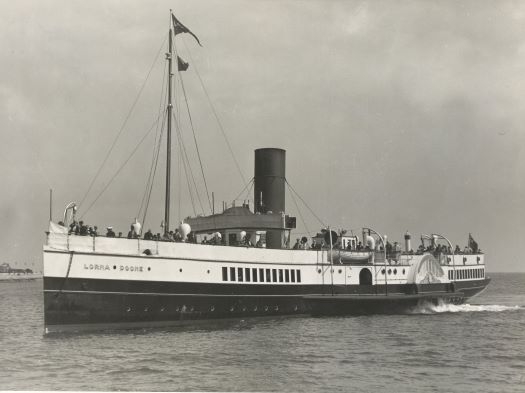
| Registration No. | 98413 |
|---|---|
| Builders | Napier Shanks & Bell, Yoker |
| Built | 1891 |
| Acquired | 1898 |
| Tonnage | 427 tonnes gross |
| Dimensions | 220'5" x 26'0" |
| Machinery | compound diagonal, paddle |
| Withdrawn | 1947 (scrapped 1948) |
Lorna Doone was acquired from John Gunn of Cardiff as a stopgap until a new steamer arrived to compete against the superior paddler Cambria owned by Messrs P. & A. Campbell. She arrived in Southampton on 1 April 1898 and on trials averaged 16.3 knots. She had one funnel initially behind an open bridge, an open foredeck with a short fore saloon with side alleyways, a full length and full width promenade deck and a full width saloon aft. The dining saloon was on the main deck; to starboard was a bar named 'Half Way Doone' and opposite on the port side a lounge bar called the 'Retreat'. She was granted a 'Steam 3' certificate for 706 persons and 818 on a 'Steam 4' and was used primarily for excursion work. A feed pump problem between Bournemouth and Weymouth on 12 September 1898 led to the hoisting of distress signals. A foresail was used to stop her drifting ashore until repairs were affected. In the winter of 1898/9 she was reboilered by J. Samuel White & Co. of Cowes and fitted with improved water-tube boilers which required two funnels. Her machinery was removed, rebuilt and a high-pressure cylinder added before refitting in the hull. There were high hopes for increased speed and less soot on the deck but this did not materialise and she was reboilered again with a locomotive type boiler, reverting to one funnel. Significant damage caused by rough weather in 1906 led to the promenade deck being carried forward to the bows and topside plating fitted. Between August 1914 and December 1919 she was used by the Navy as a minesweeper during WWI and requisitioned again in December 1939 serving as a minesweeper and anti-aircraft ship in WWII until she was released to the Company in January 1947. Her condition was so poor that repair was out of the question and so one of the Company's best loved and most successful steamers was moved, with some regret on 14 October 1948 to Pollock, Brown's yard at Northam for breaking up.
PS Victoria

| Registration No. | 82335 |
|---|---|
| Builders | Aitken & Maxwell, Glasgow |
| Built | 1881 |
| Acquired | 1899 |
| Tonnage | 366 tonnes gross |
| Dimensions | 191'9" x 25'1" |
| Machinery | compound diagonal, paddle |
| Withdrawn | 1900 (scrapped 1900) |
Built for the combined fleet of the London, Brighton & South Coast Railway and the London & South Western Railway companies, she was used on the Portsmouth to Ryde service before being purchased by the Company. Victoria was a stop-gap until PS Balmoral I arrived to counter the challenge posed by P. & A. Campbell's magnificent PS Cambria and PS Glen Rosa which had been placed at the Southampton station in 1897. Victoria was a double ended design with two funnels placed fore and aft and central paddle boxes.
PS Balmoral (I)
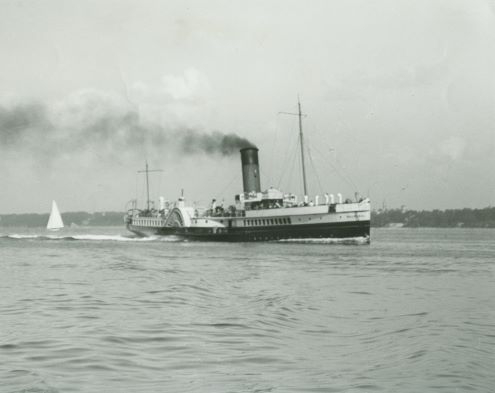
| Registration No. | 113300 |
|---|---|
| Builders | S. McKnight & Co. Ayr |
| Built | 1900 |
| Acquired | 1900 |
| Tonnage | 473 tonnes gross |
| Dimensions | 236'0" x 27'1" |
| Machinery | compound diagonal, paddle |
| Withdrawn | 1947 (scrapped 1949) |
Ordered from Hutson & Son in Glasgow (the steel hull was sub-contracted to S. McKnight & Co. of Ayr), she was promised for the 1900 season. Balmoral was fitted with compound diagonal surface condensing engines with a stroke of 66in. and cylinder diameters of 36½in. (high-pressure) and 66½in. (low-pressure). Haystack water-tube boilers of 110p.s.i were installed and the ship had five watertight compartments. Her accommodation was similar to Lorna Doone but she had a full-length promenade deck. After successful trials, attaining 19.51 knots, she was given a 'Steam 2' certificate to carry 1,033 passengers and arrived in Southampton on 14 July 1900. On her first trip on the 17 July with Directors, shareholders and invited guests aboard she encountered her rival PS Cambria, winning the first of many friendly tussles. In reality there was little to choose between them in terms of speed. Balmoral was an expensive ship to operate and her season was short but arduous, operating the long day excursions to Eastbourne, Brighton, Weymouth, Torquay and cross-Channel trips to Cherbourg and even Boulogne on occasions. She became very well known but bad weather and fog sometimes played havoc with her schedules and occasionally caused minor damage. She was reboilered in the winter of 1907/8 and requisitioned for war service in February 1915, being used mainly for troop transport before conversion into a minesweeper. She returned to the Company in February 1919, was refurbished and reboilered, resuming her duties in 1921. In WWII she was fitted out as an auxiliary anti-aircraft ship and served in the Thames area before being transferred to the Clyde to provide accommodation for shipyard workers. In January 1947 she was towed back to Southampton and sat on the mud at Northam in a very sorry condition. She was beyond economic repair and on 31 December 1948 she was taken to Pollock, Brown's yard and broken up the following year.
PS Queen (II) / Mauretania / Corfe Castle
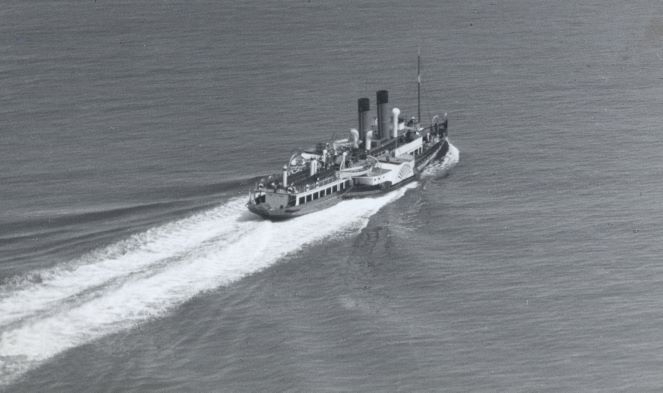
| Registration No. | 114559 |
|---|---|
| Builders | J. Reid & Co. Glasgow |
| Built | 1902 |
| Acquired | 1902 |
| Tonnage | 346 tonnes gross |
| Dimensions | 200'3" x 24'1" |
| Machinery | paddle compound diagonal |
| Withdrawn | 1938 (scrapped 1939) |
Originally designed for excursion work, she performed this role for most of her career but modifications were made to make her more versatile and permit the carriage of cars. In 1908 when returning from an excursion she smashed into rocks during a gale and the full extent of the damage was only revealed after she was slipped. In 1914 she served the admiralty in the Mediterranean performing minesweeper duties. After the war she returned to excursion duties.
PS Princess Royal
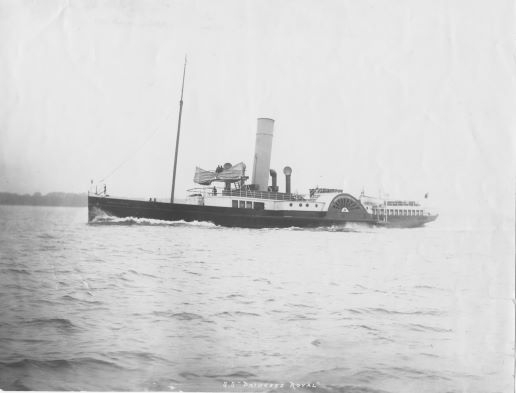
| Registration No. | 119739 |
|---|---|
| Builders | J. Thornycroft & Co Ltd, Woolston |
| Built | 1906 |
| Acquired | 1906 |
| Tonnage | 428 tonnes gross |
| Dimensions | 195'6" x 25'1" |
| Machinery | paddle compound diagonal |
| Withdrawn | 1906 (scrapped 1957) |
Most reports say that this vessel was not accepted by the Company because her speed did not meet the contract requirements, but some newspaper reports say that she did represent the Company for 3 weeks!
PS Stirling Castle
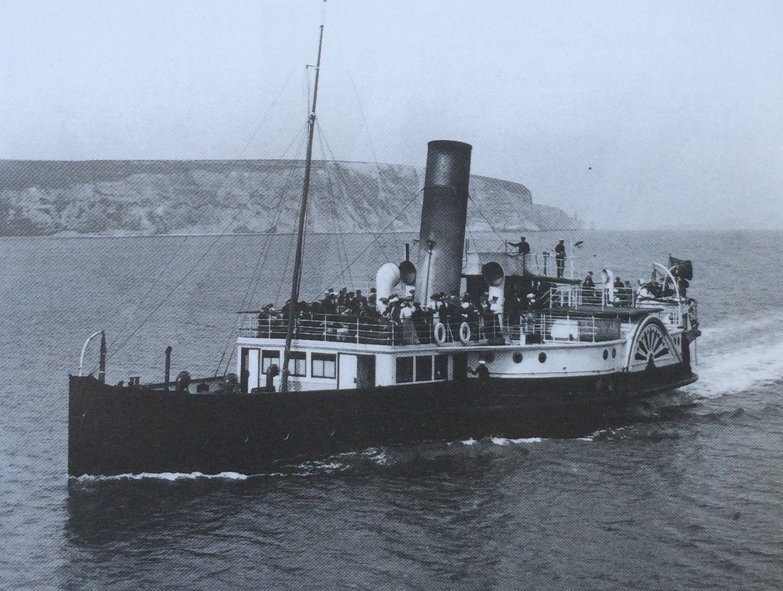
| Registration No. | 1069600 |
|---|---|
| Builders | Scott & Co. Kinghorn |
| Built | 1899 |
| Acquired | 1907 |
| Tonnage | 271 tonnes gross |
| Dimensions | 170'0" x 24'2" |
| Machinery | paddle simple diagonal |
| Withdrawn | 1916 (lost at sea) |
Serving on the Bournemouth route during her short career, the Stirling Castle was another member of the fleet who represented her country during the First World War. In 1916 whilst performing her mine sweeping duties she was sunk by an explosion just off the West coast of Malta, the cause was unknown. The Stirling Castle was the first war loss for the company.
PS Bournemouth Queen
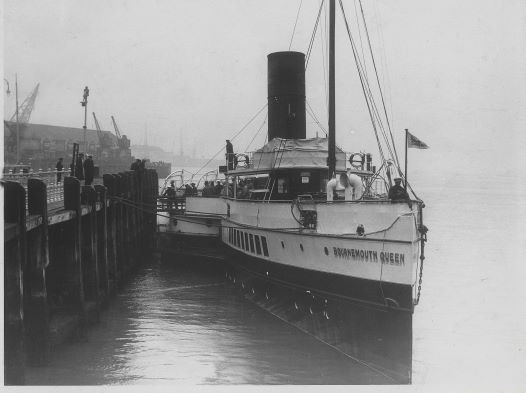
| Registration No. | 124501 |
|---|---|
| Builders | Ailsa Shipbuilding Co. Troon |
| Built | 1908 |
| Acquired | 1908 |
| Tonnage | 353 tonnes gross |
| Dimensions | 200'1" x 24'1" |
| Machinery | paddle compound diagonal |
| Withdrawn | 1957 (scrapped 1957) |
The penultimate ship to be built exclusively for excursion work, serving her namesakes route. In the First World War she served as a minesweeper, and in the Second World War she was fitted with anti-air craft guns. After the war she returned to continue her service with Red Funnel until she was scrapped in 1957.
PS Lord Elgin
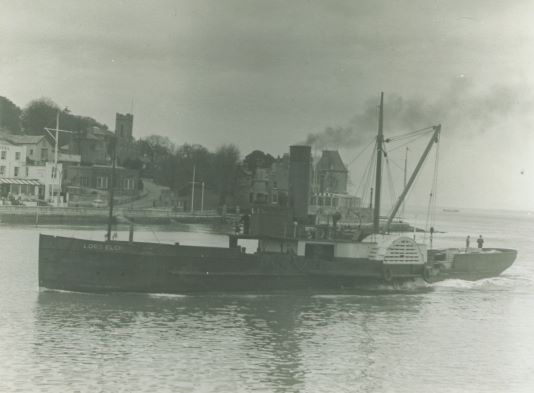
| Builders | Richardson, Duck & Co. Stockton |
|---|---|
| Built | 1876 |
| Acquired | 1908 |
| Tonnage | 203 tonnes gross |
| Dimensions | 160'0" x 20'0" |
| Machinery | paddle compound diagonal |
| Withdrawn | 1955 (scrapped 1955) |
Lord Elgin started life as a Bournemouth Steam Package Service ship until the company was bought by Red Funnel. In 1910 she was converted to cargo duties and remained a cargo steamer until finally withdrawn in 1955. From 1923 to the end of her service the Lord Elgin had the same captain; Captain Joseph Sewley.
PS Princess Mary
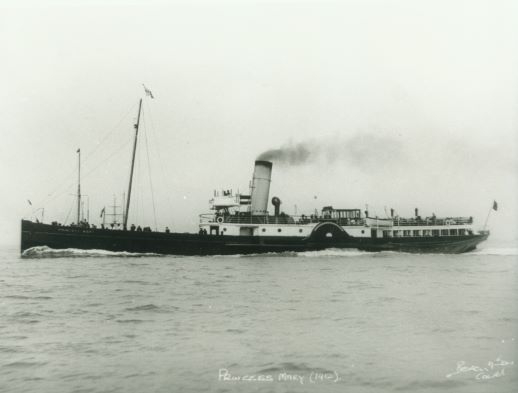
| Registration No. | 131780 |
|---|---|
| Builders | Day, Summers & Co. Northam |
| Built | 1911 |
| Acquired | 1911 |
| Tonnage | 326 tonnes gross |
| Dimensions | 195'2" x 24'1" |
| Machinery | paddle compound diagonal |
| Withdrawn | 1919 (lost at sea) |
The Princess Mary was designed as a general purpose vessel and was occasionally used for summer excursions. Her career was cut short during the First World War when her hull was ripped open after coming into contact with the wreck of HMS Majestic whilst on patrol in the Mediterranean.
PS Princess Elizabeth
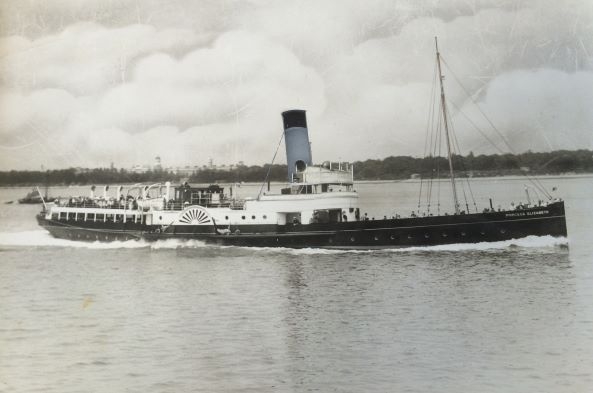
| Registration No. | 149297 |
|---|---|
| Builders | Day, Summers & Co. Ltd Northam |
| Built | 1927 |
| Acquired | 1927 |
| Tonnage | 388 tonnes gross |
| Dimensions | 195'0" x 24'2" |
| Machinery | paddle compound diagonal |
| Withdrawn | 1959 |
Sister ship of the ill fated Princess Mary. She was a Passage Steamer for the Bournemouth leg of the service until 1936 when the Gracie Fields replaced her. She, like her sister was recruited for the war effort as a minesweeper, in the Second World War. After the war she returned to her original role, the only difference was that she was based in Yarmouth and then Southsea. Her career at sea ended in 1959 whe she was sold, eventually being converted into a restaurant.
MV Medina (III)

| Registration No. | 161721 |
|---|---|
| Builders | J Thornycroft & Co. Ltd Woolston |
| Built | 1931 |
| Max Speed | 11-13 knots |
| Tonnage | 347 tonnes gross |
| Dimensions | 143'0" x 28'1" |
| Machinery | 2 x diesel, twin propeller |
| Withdrawn | 1962 |
The Medina broke with tradition, she was the first diesel driven vessel to operate on any of the Solent crossings. This was her main role even through WWII. There was space for cars and as the passenger accommodation was of a higher standard than the old paddlers she proved popular. She was unsuitable for calls at piers, owing to her widely flared bows, although pontoons were no problem. Maximum speed was 11 knots, increasing to 13 knots when re-engined in 1953. She was sold by Red Funnel in 1962 and sailed out of Gibraltar until 1971, thereafter returning to home waters and eventual convertion into a restaurant.
Sea Coach Island Enterprise

| Registration No. | 167277 |
|---|---|
| Builders | British Power Co. Ltd, Hythe |
| Built | 1933 |
| Max Speed | 20 knots |
| Tonnage | 9 tonnes gross |
| Dimensions | 36'1" x 8'2" |
| Machinery | 2 x 6cyl, 100hp, 200bhp |
| Withdrawn | 1938 |
She was the first attempt to establish a high-speed service between Southampton and Cowes. In 1936 the craft was described as a "fast (35 minute crossing), eleven passenger, powerful twin-engined motor cruiser, affording speed, comfort and safety to passengers in all weathers. The luxurious cabin was fitted with eleven coach type seats, and had toilet facilities and hand baggage accommodation." Whilst there was no winter service the Island Enterprise provided a particularly safe service in fog.
PS Gracie Fields
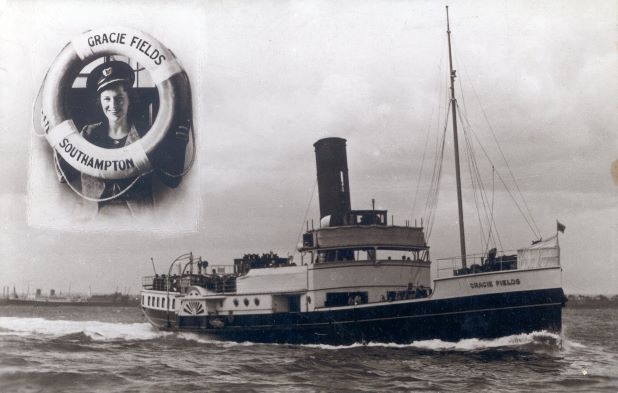
| Registration No. | 166825 |
|---|---|
| Builders | J. Thornycroft & Co. Ltd, Woolston |
| Built | 1936 |
| Acquired | 1936 |
| Tonnage | 396 tonnes gross |
| Dimensions | 195'11" x 24'11" |
| Machinery | paddle compound diagonal |
| Withdrawn | 1940 (lost at sea) |
Launched on 8 April 1936 by her namesake, who sung "Sing As We Go" at her launch. She was unusual in that she was named after a celebrity, rather than the tradition of royalty and nobility. Similar to Princess Elizabeth, she was an improved version, with a raised forecastle, designed to keep the spray off the cars she carried in her well deck. Originally she had an open bridge, but a wheelhouse was added in 1937. Performing a variety of duties including, excursions, tendering and packet services she was a popular ship. On 26 July 1936 she was chartered by her namesake to take orphans on a trip from Bournemouth to Brighton, where Miss Fields was performing. She was requisitioned for minesweeping duties in 1939 and went to Dunkirk for the evacuation. After one successful trip she was hit by a bomb and was badly damaged. Her crew were taken off by HMS Pangbourne, which tried to tow her home. However, her rudder was stuck and she was taking on water and sank on 30 May.
MV Vectra (I)
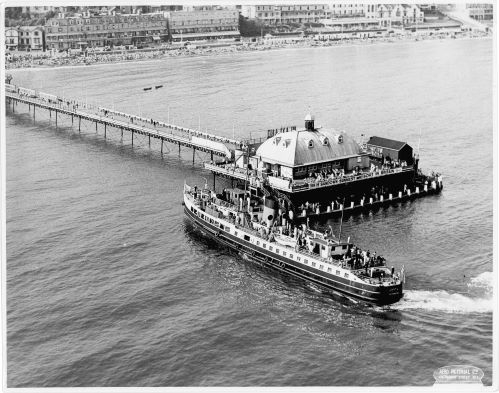
| Registration No. | 166825 |
|---|---|
| Builders | J Thornycroft & Co. Ltd Woolston |
| Built | 1938 |
| Max Speed | unknown |
| Tonnage | 630 tonnes gross |
| Dimensions | 191'6" x 30'2" |
| Machinery | English Electric Co diesels, twin Voith-Schneider propellers |
| Withdrawn | 1965 (scrapped 1996) |
The new design of the engines and propellers on this vessel gave it greater versatility and much greater manoeuvrability. Due to these qualities Vecta could be used on various duties, she tendered to some of the worlds famous liners, carried cars between Southampton & Cowes and was used for excursions. She set-off for Dunkirk for the evacuation of the British Expeditionary Force in 1939 but turned back with mechanical problems. Due to the War, obtaining spares from Germany was difficult and she was later fitted with conventional propellers. She was sold to Townsend Car Ferries Ltd for use in the Bristol Channel and renamed Westward Ho before being converted for shoreside use.
TSS Upton

| Registration No. | 147343 |
|---|---|
| Builders | Cammell Laird & Co. Ltd, Birkenhead |
| Built | 1925 |
| Max Speed | 10 knots |
| Acquired | 1946 |
| Tonnage | 462 tonnes gross |
| Dimensions | 145'1" x 32'0" |
| Machinery | steam triple expansion, twin screw |
| Withdrawn | 1950 (scrapped 1953) |
An ex Birkenhead ferry, she was purchased to help replace losses during WWII and was deployed on the Southampton-Ryde service in May 1946. Upton was a slow steamer and struggled with her schedules. She only carried passengers (no room for cars) and was tried on the Poole- Bournemouth and Swanage service. Her bulky shape and wide hull belting did not endear her to the local piermasters and after just one month she returned to Southampton. For a while she continued the Ryde service but the polio outbreak on the Isle of Wight in 1950 saw a vast drop in passengers and she was laid up at Northam. An attempt was made to try her as a tug tender in 1951 but she proved unsatisfactory and was again laid up before being scrapped in 1953.
MV Norris Castle (II)

| Registration No. | 182326 |
|---|---|
| Builders | A. Findlay, Old Kilpatrick |
| Built | 1942 |
| Max Speed | unknown |
| Acquired | 1947 |
| Tonnage | 473 tonnes gross |
| Dimensions | 180'0" x 38'1" |
| Machinery | 12 cyl oil engines, twin screw |
| Withdrawn | 1962 |
This vessel was originally designed as a landing craft for the D-day mission. As she could load from both the front and side, Norris was used on the East Cowes service. Her crossing time was longer at 1½ hours but she had a greater capacity than most of the vessels at that time. She also performed jobs tending other vessels, along with cargo runs. In 1962 she was sold to a service in the Greek Islands.
TSS Robina
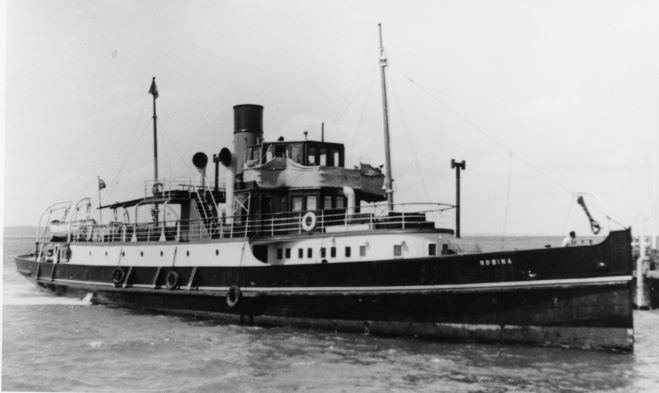
| Registration No. | 135726 |
|---|---|
| Builders | Ardrossan Dry Dock Co. Ltd |
| Built | 1914 |
| Max Speed | unknown |
| Acquired | 1948 |
| Tonnage | 306 tonnes gross |
| Dimensions | 159'6" x 26'1" |
| Machinery | twin screw, triple expansion |
| Withdrawn | 1949 (scrapped 1952) |
The Robina led a nomadic life, in her career she was owned by several companies, and to her credit managed to maintain her name through all these changes. Her career with Red Funnel was short lived due to consistent boiler troubles, she was eventually scrapped in 1952.
PS Lorna Doone (II)

| Registration No. | 148380 |
|---|---|
| Builders | Ailsa Shipbuilding Co. Troon |
| Built | 1916 |
| Acquired | 1949 |
| Tonnage | 798 tonnes gross |
| Dimensions | 235'2" x 29'1" |
| Machinery | paddle compound diagonal |
| Withdrawn | 1952 (scrapped 1952) |
Originally purchased to perform a cross channel service for Red Funnel, this former minesweeper and control ship was later used on Bournemouth excursions during the summer season. It was decided in 1952, when the vessel was being refitted, that she would be scrapped.
PS Solent Queen (II)

| Registration No. | 160696 |
|---|---|
| Builders | W. Hamilton & Co. Ltd, Port Glasgow |
| Built | 1916 |
| Acquired | 1949 |
| Tonnage | 792 tonnes gross |
| Dimensions | 234'9" x 29'1" |
| Machinery | paddle compound diagonal |
| Withdrawn | 1951 (scrapped 1951) |
The Solent Queen was the sister ship of the Lorna Doone and their careers mirrored one another. She performed the Southsea and Shanklin crossings. In 1951 when in for a refit the engine room caught fire and the Solent Queen was completely gutted.
MV Balmoral
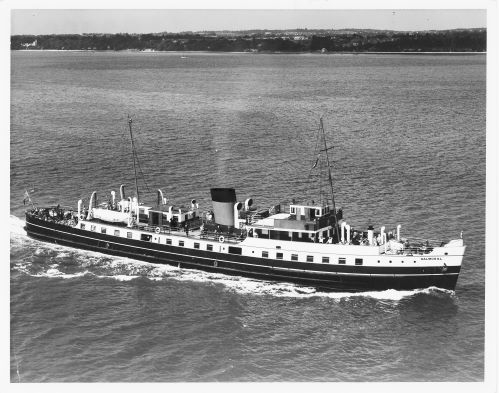
| Registration No. | 183576 |
|---|---|
| Builders | J Thornycroft & Co. Ltd Woolston |
| Built | 1949 (launched 27 June 1949) |
| Max Speed | 16.25 knots |
| Tonnage | 688 tonnes gross |
| Dimensions | 203'6" x 32'0" |
| Machinery | 2 x 6 cyl oil, twin screw |
| Withdrawn | 1969 (sold to P&A Campbell) |
With capacity for 10 cars, Balmoral's main role was the Southampton-Cowes service but at times she performed tending and excursion duties. Adjustments to the vessel were made as her role became more orientated around the excursions until they finally ended in 1968. After this the Balmoral was sold and has had a number owners since. She is now owned by Waverley Steam Navigation Limited and operates excursions throughout the summer. On 27 June 2009 the ship celebrated her Diamond Jubilee.
MV Carisbrooke Castle
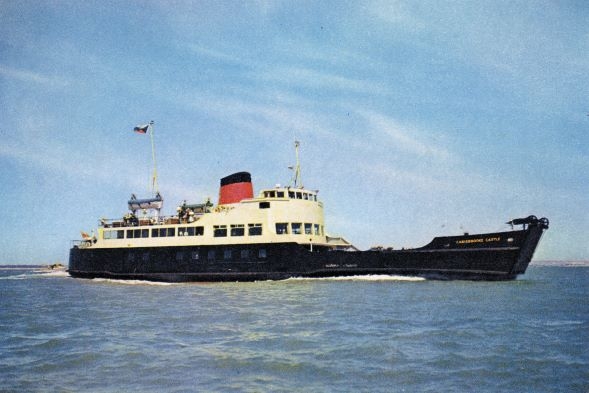
| Registration No. | 300672 |
|---|---|
| Builders | J Thornycroft & Co. Ltd Woolston |
| Built | 1959 |
| Max Speed | 18 knots |
| Tonnage | 672 tonnes gross |
| Dimensions | 191'2" x 42'2" |
| Machinery | 2 x 8 cyl oil, twin screw |
| Withdrawn | 1974 |
A purpose built passenger vehicle ferry. Although not an attractive ship, she was effective in her role, carrying 15,829 cars and 3,147 commercial vehicles in the first six months. She could alo make the trip to Cowes in 40 minutes! She had a couple of collisions, the worst was with an Esso Tanker in 1964 in thick fog, no injuries were reported. With the arrival of the Netley Castle she was sold to operate in Naples.
MV Osborne Castle
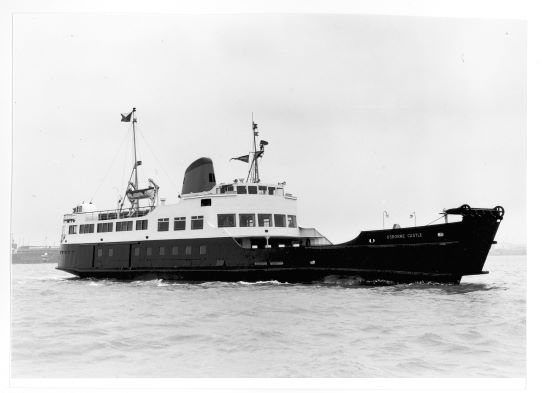
| Registration No. | 303396 |
|---|---|
| Builders | J Thornycroft & Co. Ltd Woolston |
| Built | 1962 |
| Max Speed | unknown |
| Tonnage | 736 tonnes gross |
| Dimensions | 191'2" x 42'1" |
| Machinery | 2 x HRN 8/45 diesels, twin screw |
| Withdrawn | 1978 |
The Osborne Castle was seen as an improvement on her sister ship the Carisbrooke Castle. Despite this she was mainly restricted to tender work because her design meant she was unsuitable for pier work. She continued until 1978 when she was sold to a Canadian ferry company.
MV Cowes Castle
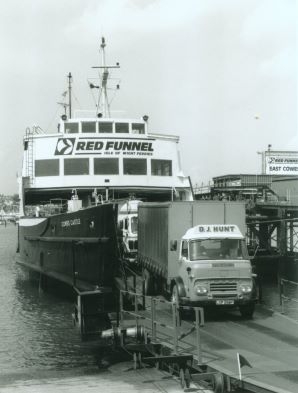
| Registration No. | 307303 |
|---|---|
| Builders | J Thornycroft & Co. Ltd Woolston |
| Built | 1965 |
| Max Speed | 12 knots |
| Tonnage | 786 tonnes gross |
| Dimensions | 191'0" x 41'6" |
| Machinery | 2 x 8 cyl Premier diesels, twin screw |
| Withdrawn | 1994 |
The Cowes Castle was of a similar shape to the Osborne Castle up until 1975 when she was converted to become a roll-on roll-off ferry. Mezzanine decks were also fitted to enable her to carry an extra 25 to 30 cars. On arrival of Red Falcon in 1994 she was sold to Jadrolinija for service in Croatia.
MV Norris Castle
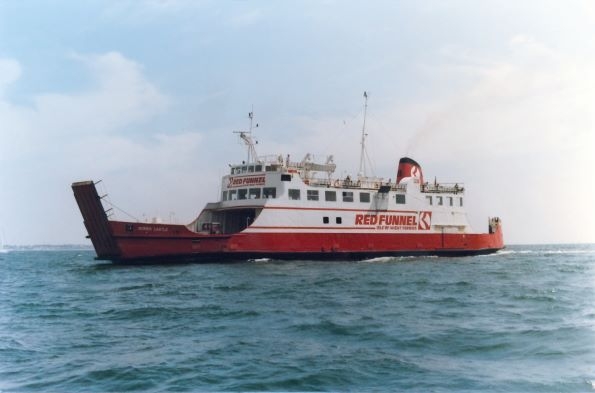
| Registration No. | 336718 |
|---|---|
| Builders | J Thornycroft & Co. Ltd Woolston |
| Built | 1968 |
| Max Speed | 12 knots |
| Tonnage | 734 tonnes gross |
| Dimensions | 191'3" x 42'1" |
| Machinery | 2 x 8 cyl Premier diesels, twin screw |
| Withdrawn | 1994 |
The Norris Castle was a modernized version of her namesake and principally used for commercial vehicles in her early life. Like the Cowes Castle, she was later converted to a roll-on roll-off ferry and mezzanine decks were fitted. In gale force winds in 1981 when turning in the River Medina she was blown on to the Cowes floating bridge but there was no real damage done to either vessel. On the arrival of Red Osprey in 1994 she, like her sister was sold to Jadrolinija for service in Croatia.
Shearwater

| Registration No. | 336741 |
|---|---|
| Builders | Sea Flight SpA, Sicily |
| Built | 1969 |
| Max Speed | 32 knots |
| Tonnage | 26 tons displacement |
| Dimensions | 61'0" x ? |
| Machinery | 2 x 530 hp Fiat diesels, twin screw |
| Withdrawn | 1973 |
The demand for a quicker crossing time led Red Funnel to experiment with different types of high-speed passenger craft. Shearwater was the first of 5 hydrofoils that were introduced during this period. She carried 54 passengers at a speed of between 32-35 knots, the the only problem was reliability. When Shearwater 3 arrived this craft was used as a standby vessel, she was disposed of in 1973.
Shearwater II

| Registration No. | unknown |
|---|---|
| Builders | Seaflight SpA, Sicily |
| Built | 1970 |
| Max Speed | 32.5 knots |
| Tonnage | 26 tons displacement |
| Dimensions | 61'0" x ? |
| Machinery | 2 x 530 hp Fiat diesels, twin screw |
| Withdrawn | 1971 |
Convinced there was a market for speed and that the hydrofoil design philosophy was suitable, the company bought Shearwater 2 to improve reliability. This did not prove to be the case and instead she was used as parts to maintain the original hydrofoil. In 1974 she was towed to Portsmouth for scrapping but ended up being sold to operate a ferry service in Loch Fyne.
Shearwater III

| Registration No. | 357766 |
|---|---|
| Builders | Rodriguez, Messina |
| Built | 1972 |
| Max Speed | 32.5 knots |
| Tonnage | 35.1 tons displacement |
| Dimensions | 73'0" x ? |
| Machinery | 1 x 1350 hp V12 Maybach diesel |
| Withdrawn | 1992 |
This new improved hydrofoil with a powerful Mercedes engine proved to be far more reliable and became the mainstay of the service. She could carry 67 passengers and do the crossing in 23 minutes at 32.5 knots. This led to the reintroduction of a winter service. She was held in reserve after the arrival of Red Jet 1 in 1991 and later sold in 1992.
Shearwater IV

| Registration No. | 351756 |
|---|---|
| Builders | Rodriguez, Messina |
| Built | 1973 |
| Max Speed | 32.5 knots |
| Tonnage | 35.1 tons displacement |
| Dimensions | 73'0" x ? |
| Machinery | 1 x 1350 hp V12 Maybach diesel |
| Withdrawn | 1992 |
This vessel joined the fleet in August 1973, joining her identical sister Shearwater 3. The vastly improved reliability of these two craft made the previous two hydrofoils redundant. She was demoted to back-up boat after the arrival of Red Jet 2 in 1991 and sold a year later in 1992.
MV Netley Castle
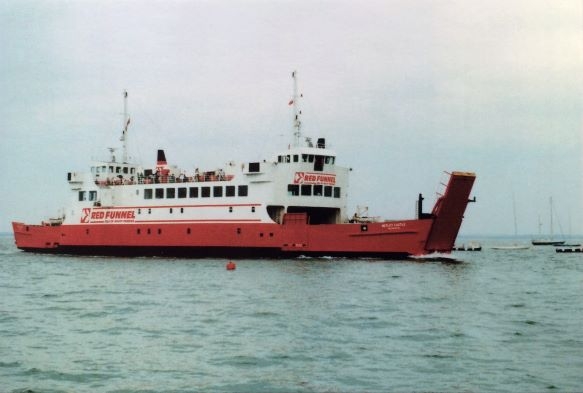
| Registration No. | 361802 |
|---|---|
| Builders | Ryton Marine Ltd, Wallsend |
| Built | 1974 |
| Max Speed | 14 knots |
| Tonnage | 1183 gross tonnes |
| Dimensions | 242'2" x 49'9" |
| Machinery | 4 x 8 cyl Caterpillar diesels, 4 x steerable propellers |
| Withdrawn | 1997 |
At the time, Netley Castle was the largest vessel built by Red Funnel and was capable of carrying 80 cars (with mezzanine decks deployed) and nearly 1,000 passengers. She was a true doubled-ended design with two wheelhouses which meant on the Southampton-Cowes run she did not have to turn around. With 4 separate Caterpillar engines each driving a steerable propeller, reliability was excellent. On the arrival of Red Eagle in 1996, the Netley Castle was sold to Jadrolinija, joining her old running mates in Croatia.
HM2 GH2019
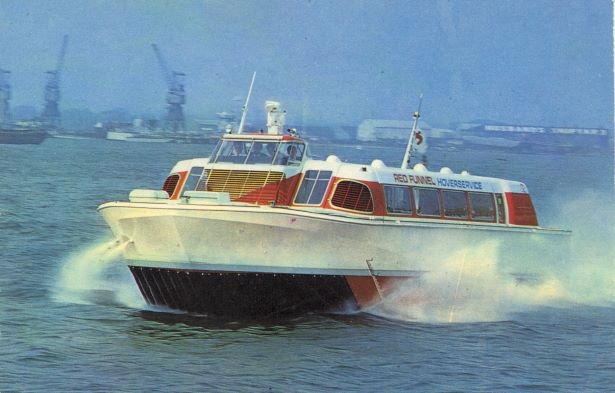
| Registration No. | unknown |
|---|---|
| Builders | Hovermarine Ltd |
| Built | 1969 |
| Acquired | 1981 |
| Tonnage | unknown |
| Dimensions | 51'0" x 20'0" |
| Machinery | 3 x Cummins diesels |
| Withdrawn | 1982 |
This hovercraft was chartered to help meet increased demand but in the main she was used for transporting shipyard workers between East Cowes and Vosper Thornycrofts Itchen yard. After the arrival of the fourth hydrofoil, Shearwater IV, the craft was no longer required.
HM2 GH2024
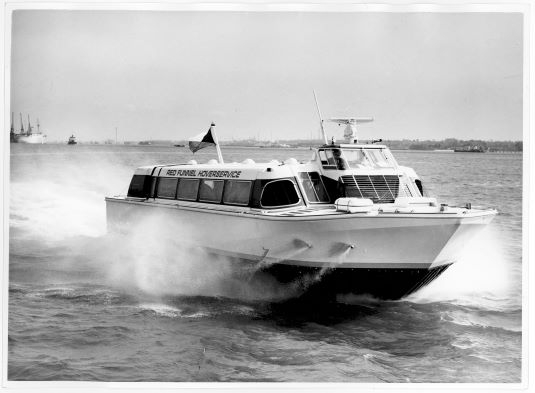
| Registration No. | unknown |
|---|---|
| Builders | Hovermarine Ltd |
| Built | 1969 |
| Acquired | 1981 |
| Tonnage | unknown |
| Dimensions | 51'0" x 20'0" |
| Machinery | 3 x Cummins diesels |
| Withdrawn | 1982 |
This was the second hovercraft taken on by Red Funnel to meet the increased demand for high-speed services. She was mainly used on the shipyard service but occasionally appeared on the scheduled Southampton-Cowes run.
Shearwater VI

| Registration No. | 700233 |
|---|---|
| Builders | Rodriguez, Messina |
| Built | 1982 |
| Max Speed | 33.5 knots |
| Tonnage | 31.5 tons displacement |
| Dimensions | 20.95m in length |
| Machinery | 1 x 1287 hp V12 331 MTU diesel, single screw |
| Withdrawn | 1999 |
The arrival of Shearwater 6 from Italy, the fourth in her class left the two hovercraft redundant. Her arrival consolidated the high speed service as there was now sufficient back-up craft to improve resilience and cope with peak demand like Cowes Week. Like her sister, Shearwater 6 acted in a back-up role after the arrival of Red Jet 1 & 2 in 1991 and was eventually withdrawn in 1999 after the delivery of Red Jet 3 in 1998. She was sold to dive operators in Thailand.
Red Jet 1
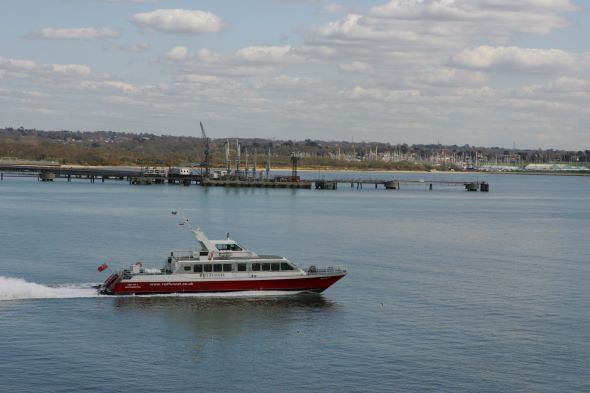
| Registration No. | 719584 |
|---|---|
| Builders | FMB Marine, Cowes |
| Built | 1991 |
| Max Speed | 35.5 knots |
| Tonnage | 168 gross tonnes |
| Dimensions | 32.5m x 8.4m |
| Machinery | 2 x 1360 kW 12V 396TE84L MTU diesels, 2 x MJP waterjets |
| Withdrawn | 2009 |
Red Jet 1 proved to be a revolutionary step forward and was the first waterjet propelled scheduled high-speed ferry on the Solent. Accommodating 138 passengers in comfort and offering excellent visibility, she completed the crossing at 32.5 knots in just 22 minutes. Her arrival led to the withdrawal and sale of Shearwater 3 in 1992. The delivery of Red Jet 3 in 1998 meant the normal two boat service was shared between Red Jet's 1, 2 and 3 but Red Jet 4's arrival in 2003 relegated Red Jet 1, like her sister, to a back-up role. She was sold in May 2009 to Caspian Mainport for continued service in the Black Sea.
Red Jet 2
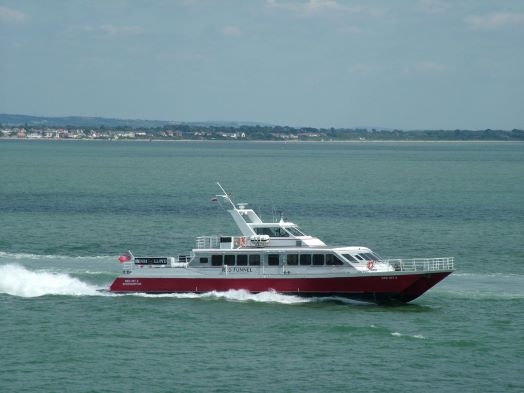
| Registration No. | 721064 |
|---|---|
| Builders | FMB Marine, Cowes |
| Built | 1991 |
| Max Speed | 35.5 knots |
| Tonnage | 168 gross tonne |
| Dimensions | 32.5m x 8.4m |
| Machinery | 2 x 1360 kW 12V 396TE84L MTU diesels, 2 x MJP waterjets |
| Passengers | 138 seated |
| Withdrawn | 2009 |
Identical to her sister Red Jet 1, the new craft were an instant hit with customers and set new standards of comfort and all weather reliability. Her arrival led to the withdrawal and sale of Shearwater 4 in 1992. The delivery of Red Jet 3 in 1998 meant the normal two boat service was shared between Red Jet's 1, 2 and 3 but Red Jet 4's arrival in 2003 relegated Red Jet 2, like her sister, to a back-up role. Red Jet 2 was sold in May 2009 to Caspian Mainport for continued service in the Black Sea.
MV Red Falcon
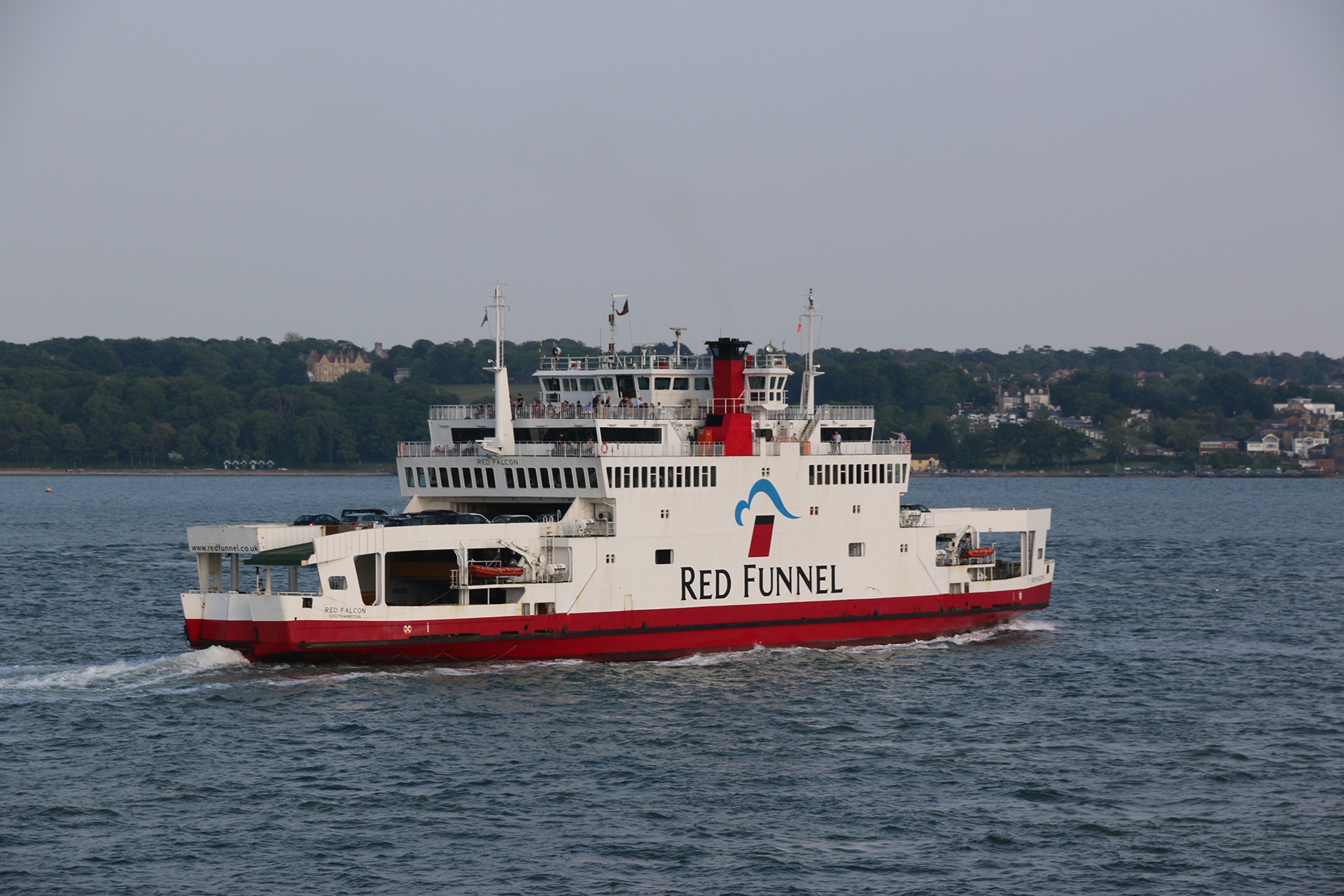
| Registration No. | 9064047 |
|---|---|
| Builders | Ferguson Shipbuilders, Port Glasgow |
| Built | 1994 |
| Max Speed | 14 knots |
| Tonnage | 3,953 gross tonnes |
| Dimensions | 93.22m x 17.5m |
| Machinery | 2 x FHD240 Watsila diesels, 2 x Voith Schneider propellers |
| Passengers | 892 |
One of two identical sisters ordered in 1993, the Raptor class as they were known, were a doubled-ended design with a central bridge affording excellent all-round visibility. There was no centre casing to impede loading and deployable mezzanine decks could be deployed in various configurations to improve flexibility. Voith Schneider propulsion, trialled on previous vessels in the fleet, gave excellent manoeuvrability, enabling her to turn on her own axis and even move sideways! Red Falcon entered service in April 1994 wearing the Company's new corporate identity and was an instant hit compared to the old Castle class ships. Red Falcon, like her sisters was lengthened and fitted with a new car deck by Remontawa Shipyard in Gdansk between Jan-Mar 2004. This increased her capacity to approximately 220 cars. In 2014, the ship received a £2.2m interior refit which included fitting two new lounges on A deck and the creation of a new exterior AA deck.
MV Red Osprey
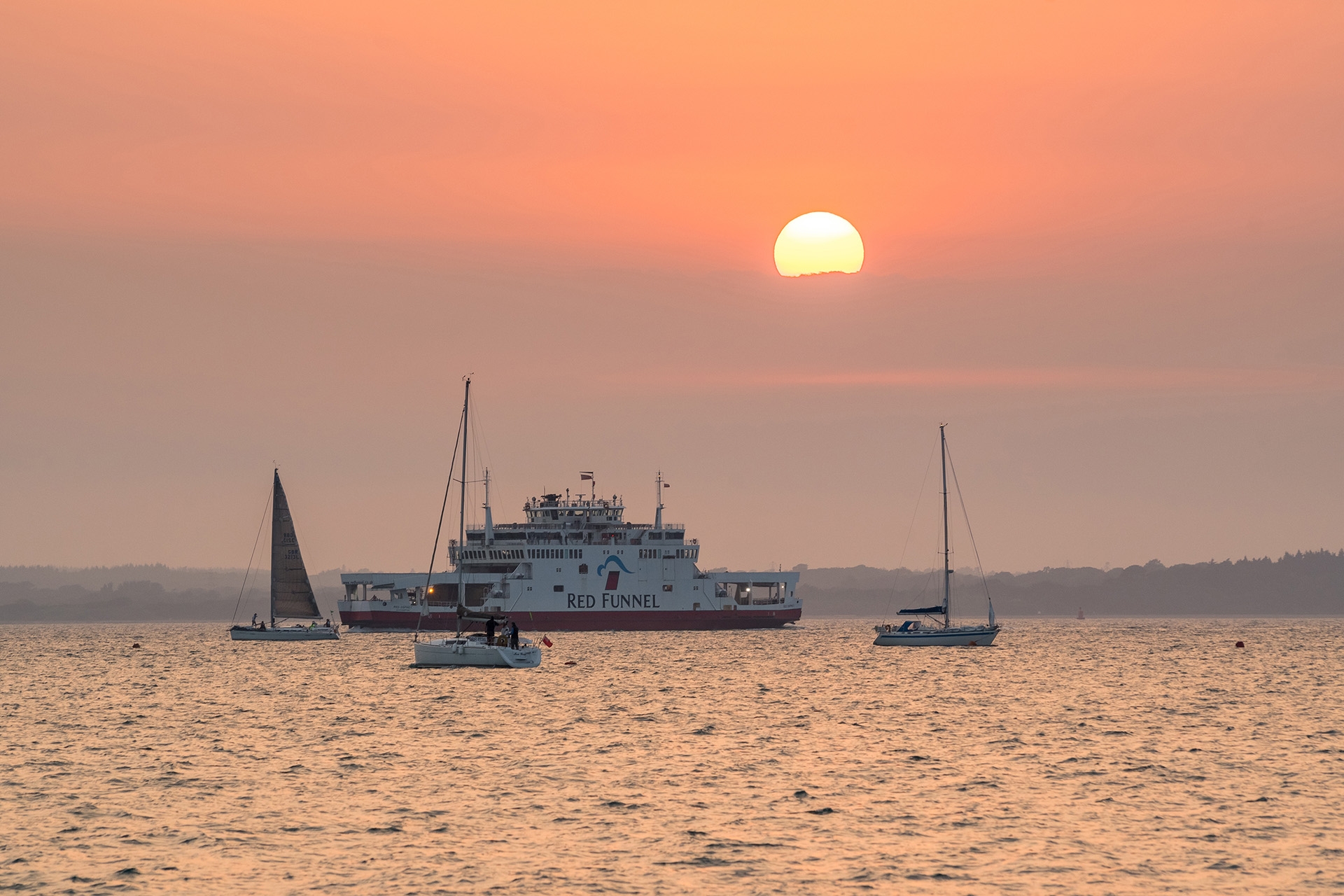
| Registration No. | 9064059 |
|---|---|
| Builders | Ferguson Shipbuilders, Port Glasgow |
| Built | 1994 (modified in 2003) |
| Max Speed | 14 knots |
| Tonnage | 3,953 gross tonnes* |
| Dimensions | 93.22m* x 17.5m |
| Machinery | 2 x FD340 Watsila diesels, 2 x Voith Schneider propellers |
| Passengers | 895 |
Sister ship to Red Falcon, Red Osprey entered service in October 1994 after being delayed on route from the shipyard by extreme weather in the Irish Sea. Identical to the Red Falcon, she was the first of the class to be lengthened and fitted with an additional end-to-end car deck. The work was carried out between October and December 2003 by Remontawa Shipyard in Gdansk, Poland. Red Osprey returned to service with a new red and white paint scheme and the Company's logo on her sides. At the time she was the largest ferry ever to serve the Isle of Wight. In 2015, like her sister, the ship received £2.2m interior refit which included fitting two new lounges on A deck and the creation of a new exterior AA deck.
MV Red Eagle
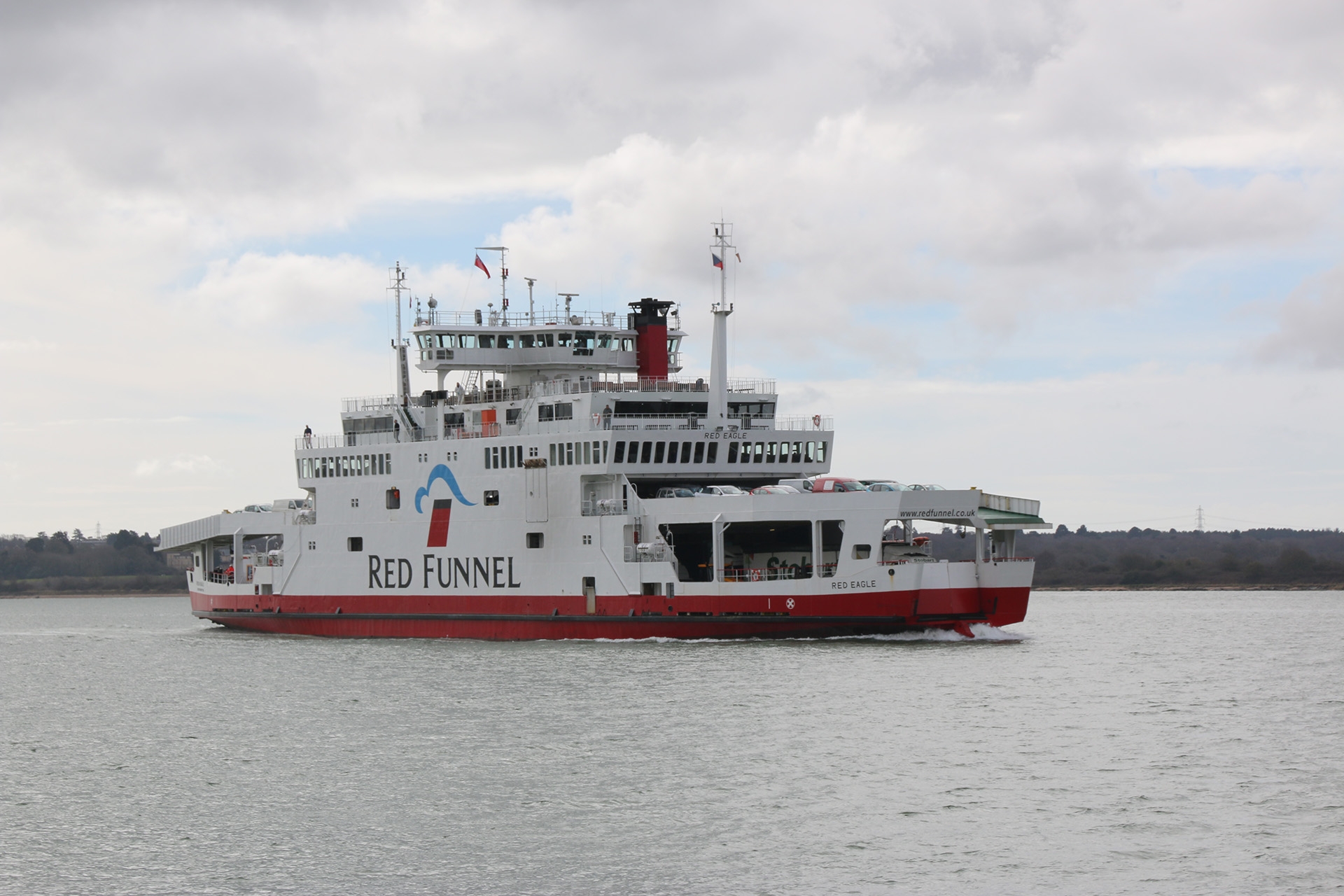
| Registration No. | 9117337 |
|---|---|
| Builders | Ferguson Shipbuilders, Port Glasgow |
| Built | 1996 |
| Max Speed | 14 knots |
| Tonnage | 4,075 gross tonnes |
| Dimensions | 93.22m x 17.5m |
| Machinery | 2 x FD340 Watsila diesels, 2 x Voith Schneider propellers |
| Passengers | 894 |
Surging demand for cross-Solent travel brought the order for this ship forward from 1998 to 1996. Red Eagle, the Company's flagship can be distinguished from her two sister Raptor class vessels by having a taller funnel and a raised bridge which was designed to maintain sight-lines fore and aft. This was necessary due to the increased length of the passenger accommodation deck. The higher bridge section also provided more office and meeting room space for the crew. In the winter of 2004, Red Eagle was fitted with a new mid-section and a new end-to-end car deck, increasing vehicle capacity to 220 cars. She returned to the Solent in early Jan 2005 and entered the record books as the largest ferry to serve the Isle of Wight, a record she holds to this day.
Red Jet 3
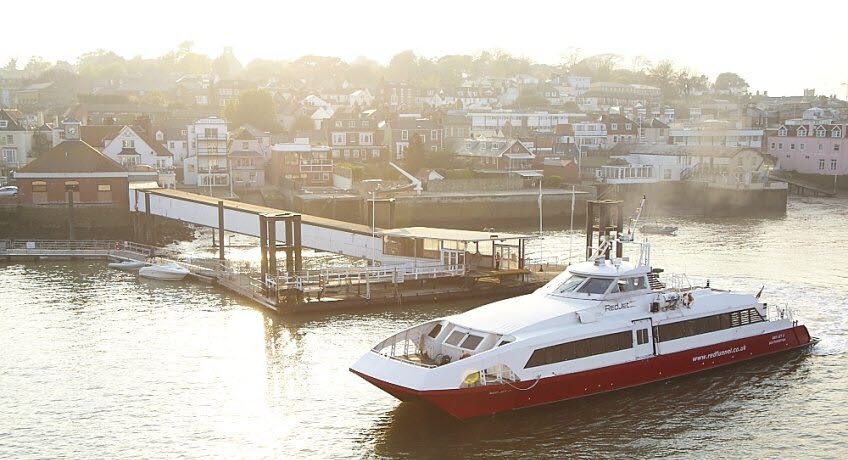
| Registration No. | 901323 |
|---|---|
| Builders | FMB Marine, Cowes |
| Built | 1998 |
| Max Speed | 38 knots |
| Tonnage | 213 gross tonnes |
| Dimensions | 32.90m x 8.32m |
| Machinery | 2 x 1500 kW 12V 396TE74L MTU diesels, 2 x MJP waterjets |
| Passengers | 184 seated |
A similar hull form to Red Jet 1 & 2, Red Jet 3 provided much needed seating capacity to help cope with increasing numbers of commuters on the West Cowes-Southampton route. Higher rated engines provided a top speed of 38 knots and trim-tabs helped ensure the low-wash characteristics of the design were maintained. Onboard, passengers were treated to a drinks service, improved ventilation and a video safety announcement. Red Jet 3 is the work horse of the fleet and in 2007 leather seats and LCD screens were added together with improved luggage space.
Red Jet 4
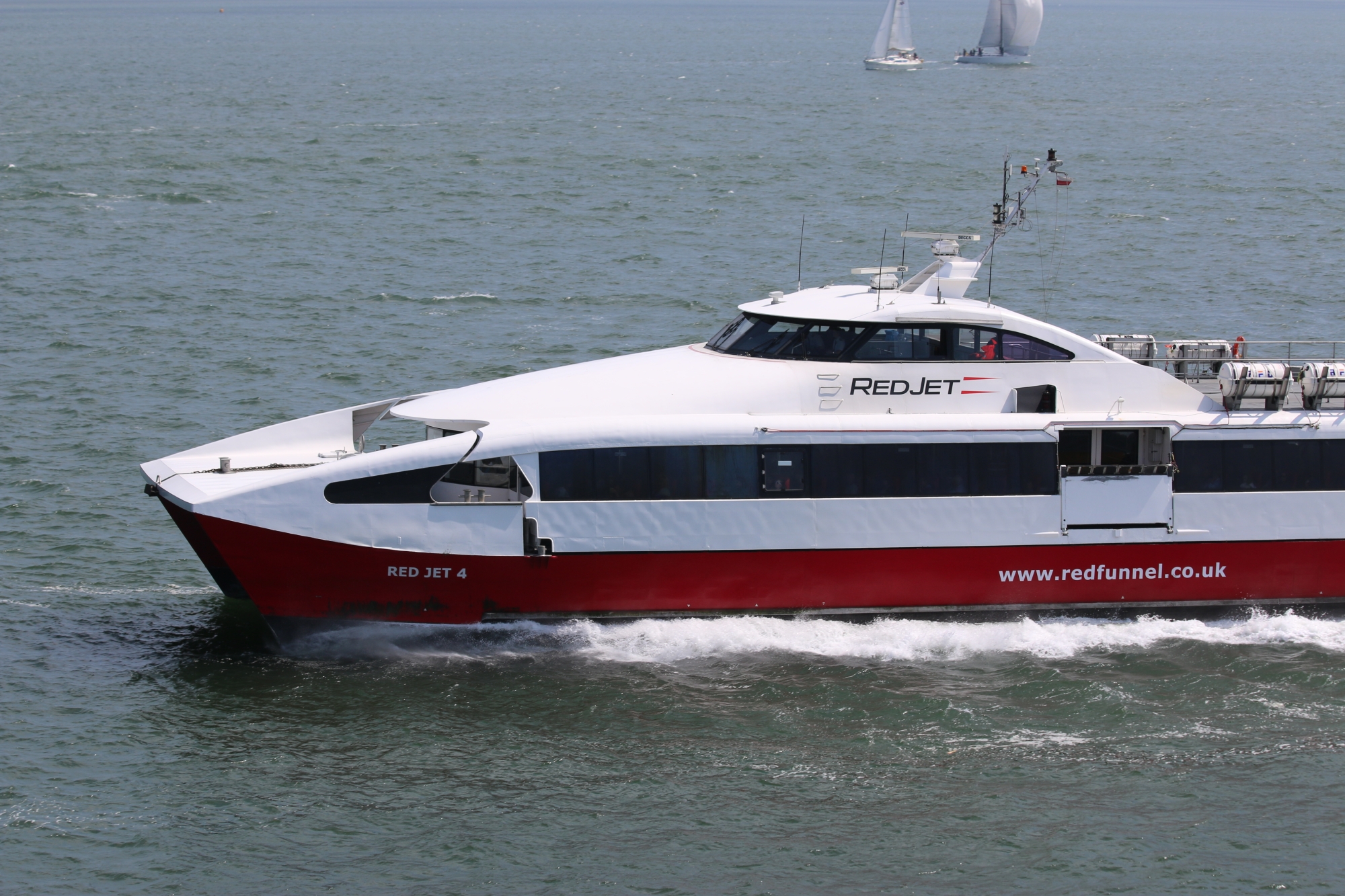
| Registration No. | 906937 |
|---|---|
| Builders | North West Bay Ships Pty, Hobart |
| Built | 2003 |
| Max Speed | 42 knots |
| Tonnage | 342 gross tonnes |
| Dimensions | 39.88m x 10.82m |
| Machinery | 2 x 1740 kW 12V 4000 M70 MTU diesels, 2 x MJP waterjets |
| Passengers | 275 seated |
Built in Hobart, Tasmania, Red Jet 4 is the only vessel Red Funnel has built outside the UK and offers a big step forward in terms of ride comfort, speed and low-wash. Anti-vibration mountings separate the hull from the cabin to reduce noise and vibration, whilst vertical interceptors lift the aft section of the hull when deployed at speed to reduce wash. Capable of speeds in excess of 41 knots, Red Jet 4 is the fastest commercial passenger catamaran in the Solent.
MV Bergen Castle
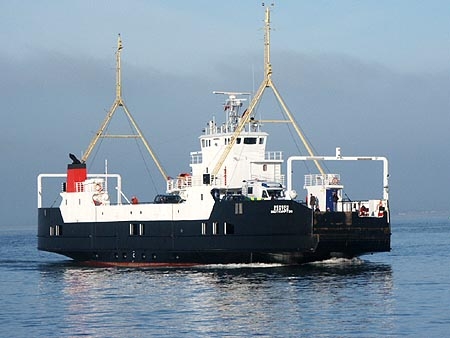
| Registration No. | unknown |
|---|---|
| Builders | Loland VFT, Norway |
| Built | 1976 |
| Max Speed | 12.5 knots |
| Acquired | 2003 |
| Tonnage | 1,220 gross tonnes |
| Dimensions | 66.02m x 12.25m |
| Machinery | 1650 hp Normo LDMB-9, 1 x variable pitch propeller each end |
| Withdrawn | 2005 |
Purchased from a Norwegian operator, Bergen Castle was a temporary vessel used to maintain the service whilst the Company's 3 Raptor ships were away being stretched and refitted in Poland. Bergen Castle took over Red Osprey's duties in October 2003 and covered for both Red Falcon and Red Eagle. She had 2 cargo decks, accommodating about 85 cars & 5 lorries, a side mounted bridge with two control positions and 2 passenger saloons for up to 250 people. She was fitted with a single variable pitch propeller mounted at either end. Although inferior to the Raptor fleet in terms of speed, manoeuvrability, capacity and interior comfort she provided a useful role until the Red Eagle returned from Gdansk. She was withdrawn in early 2005, sold to Greek interests in Nov 2005 and renamed Stella.
Red Jet 6
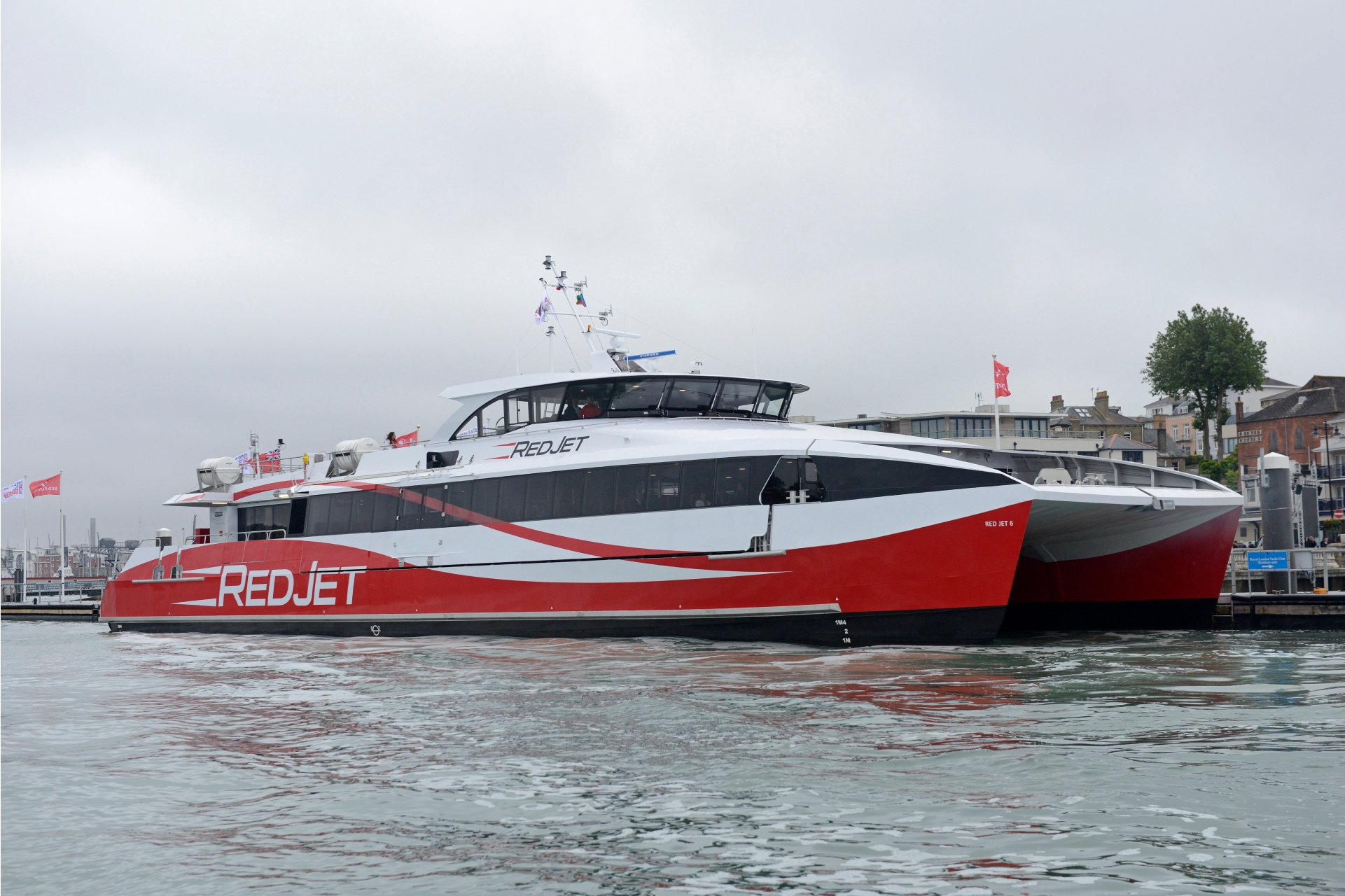
| Registration No. | 9788083 |
|---|---|
| Builders | Shemara Refit LLP, East Cowes, Isle of Wight UK |
| Built | 2016 |
| Max Speed | 42 knots |
| Dimensions | 41.12m x 10.87m |
| Machinery | 4 x 900 kW 10V 2000 M72 MTU diesels, 4 x MJP 500 DRB waterjets |
| Passengers | 275 seated |
Red Jet 6 is the first vessel of her kind to be built in the UK since 2000 and the first such vessel Red Funnel has built on the Isle of Wight since Red Jet 3 in 1998. Red Jet 6 is very similar to Red Jet 4 but she incorporates a lot of new technology to improve passenger comfort and reliability and reduce through-life running costs. The £6m vessel has 4 engines and 4 waterjets for redundancy and can easily operate on 2 or 3. To reduce weight, she is covered in special marine grade vinyl instead of paint and from a bridge perspective, her controls and navigation aids are state-of-the-art.


